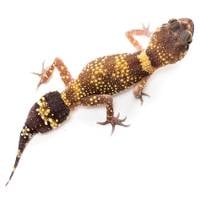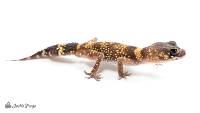Josh's Frogs
Australian Barking Gecko (Nephrurus milii) Care Sheet
By Will Gyurgyik
The Australian barking gecko is small, nocturnal, and terrestrial. These lizards aren't always commercially available, though they are interesting and great for beginners or more advanced hobbyists.
NAME
Nephrurus milii is known as Australian barking geckos. Hatchlings and juveniles are known to vocalize when threatened. (In captivity, however, this trait usually disappears with age as they become accustomed to human interaction).
COLORATION
These geckos are often red-orange to orange in color with yellow or cream interrupted banding and spotting. They have a black tail with the same banding.
HOUSING
Juveniles or a single adult can be kept in a 12x12x12 enclosure. Pairs or trios should be provided with more space, such as a 10 gallon or 18x18x12 enclosure. Males should never be housed together. Sand works well as a substrate. Numerous hides should be provided; slate, cork flats, or even everyday items like overturned flower saucers work well. Additionally, low climbing materials like rocks, driftwood, cork bark, manzanita branches, and other rough surfaces can be added. Support these by the bottom of the enclosure instead of the substrate. Succulents and arid plants can also be provided in your enclosure.
TEMPERATURE
Keep Australian barking geckos between 74-78 F. Australian barking geckos should not be provided a hot spot as hot as other desert species. Instead, provide a basking spot of around 84-86 F, preferably maintained with an under tank heater. Be sure to use a thermostat to prevent overheating. Temperature should be monitored with a digital thermometer, and the basking spot can be checked with an infrared thermometer. Night temperatures should not fall below 65 F. UV light is not required for this nocturnal species.
HUMIDITY
Keep Australian barking geckos at 30-40% humidity. Ambient humidity should be monitored with a digital hygrometer. A humid hide is recommended for this species to provide a humid microclimate. These geckos should be lightly misted once or twice a week. Simply moisten a portion of the substrate and provide dew on enclosure walls and cage items from which they can drink. However, be sure that enough ventilation is provided to allow the enclosure to dry out after a few hours. A shallow water dish can be provided but isn't necessary with regular misting.
SIZE
Australian barking geckos hatch out at about 1.5 inches, with adults reaching around 4.5 inches from head to tail.
DIET
Australian barking geckos are insectivores and should be provided with a varied diet of insects. Juveniles can take ¼-inch crickets or dubia roaches. These juveniles can also be occasionally offered small to medium black soldier fly larvae and small mealworms. Adults should be fed a staple of 1/2-inch crickets or dubia roaches. They can be offered other feeder insects as well, such as black soldier fly larvae, and mealworms. Waxworms, silkworms, or butterworms can also be an occiasional treat. All feeder insects should be gut loaded and dusted with vitamin/mineral supplements, and can be offered in a food dish.
SEX
Adult male Australian barking geckos will exhibit a bulge at the base of the tail.
BREEDING
A light brumation period in the winter or longer days in the summer will help incite breeding. Females lay around 6 pairs of eggs during the breeding season. Eggs are buried in substrate or may be deposited in a humid hide if one is provided. In any event, they should be carefully removed and incubated.
CONCLUSION
Between their ease of care and beautiful colors, Australian barking geckos are a good gecko choice.
Check out all geckos at Josh's Frogs here:
LINKS OF INTEREST
https://www.reptilesmagazine.com/care-tips-for-the-australian-barking-gecko/



